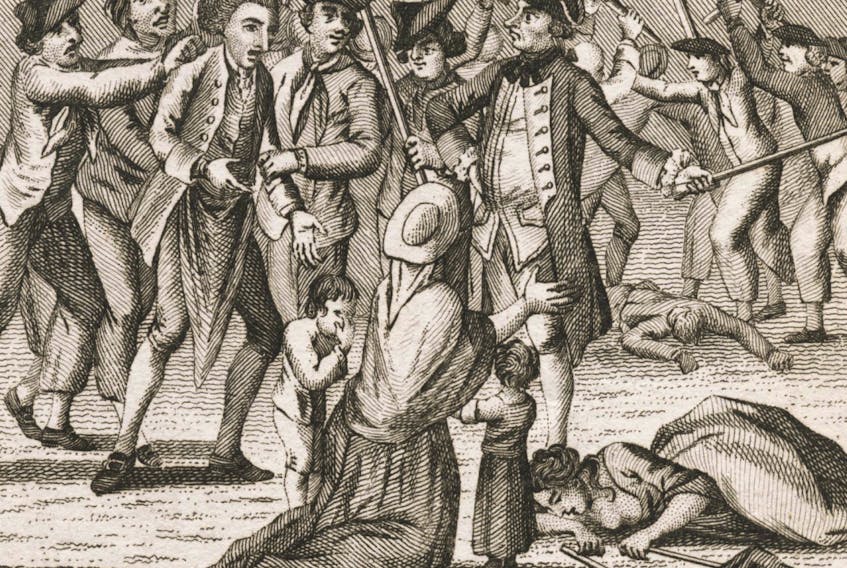4 January 1956 – The MV Bluenose began its ferry service between Yarmouth and Bar Harbour, Maine. Operated at the time by Canadian National Railways (later CN Marine), she had a crew of 96 and could carry up to 615 passengers, 150 vehicles and 18 trucks.
After her service ended in 1982, she was sold to other commercial interests and was finally scrapped in Mexico in 2000. Her wheel, compass, telegraph and ship’s bell were donated to the Yarmouth County Museum.

5 January 1978 - William Knapp Buckley died. Born in 1890 in Wallace, Nova Scotia, he grew up in Sydney. Influenced by his older brother Donald, who ran a pharmacy in Sydney, William undertook pharmacist studies in Toronto in 1914.
By 1920, William established W.K. Buckley Ltd. to manufacture a strong cough suppressant he developed known as Buckley's Mixture. It is believed it started when he spent time working in his brother’s pharmacy in Sydney (on the corner of Prince and Charlotte Streets).
Later William’s adopted son, Frank Buckley (1921-2016) inherited the business and by 1985 he became the spokesperson for the well-known ad campaign for Buckley's original mixture with the now famous tagline: "It tastes awful. And it works." The Swiss-based conglomerate, Novartis, purchased ownership of the Buckley's brand and formulas in 2002.

6 January 1781 – Violence erupts on the Halifax waterfront after an armed party of Royal Navy sailors and an officer (known then as a press gang) seized several young men in the town and paraded them down to the waterfront and onto British ships of war. Similar scenes were also occurring in coastal towns such as Lunenburg and Liverpool.
Since the 1740s, the British Royal Navy had what was known as the Impress Service, whereby with government sanctioned approval, they could forcibly conscript individuals, supplies and needed transportation for military purposes. It became known as impressment.
With the outbreak of the American Revolution in 1775, the Royal Navy’s traditional volunteer source of labour in the American colonies was severed. As a result, the navy expected loyalist colonies such as Nova Scotia to make up for the shortage in their naval manpower. However, there was also stiff competition for sailors needed on trading vessels involved either in the local fishery, or in the lucrative privateering trade. With no volunteers readily available, the navy used impressment to search for and obtain men for their ships on land and sea.
Soon merchants in Halifax and other coastal communities began to petition the lieutenant governor to address the tensions and social unrest caused when a press gang (usually a group of ten seamen led by an officer) entered their communities and roamed the streets seeking new recruits against their wills, often bounding and marching them through the streets as if they were criminals. Many were never heard from again.
Press gang activities would continue up to the Napoleonic Wars and would have lasting effects on civil-naval relations in the province of Nova Scotia for years to come. Impressment was never formally abolished.
7 January 1835 – Joseph Howe published a letter in his Novascotian newspaper criticizing members of the local police and magistrates for pocketing public monies through various fines.
The letter was had been signed by “the people.” On Feb. 4, Attorney General S.G.W. Archibald charged Howe with seditious libel. The court date was scheduled for March 2 before Chief Justice Brenton Haliburton.
Howe would defend himself in a six-hour trial whereupon within 10 minutes the jury found him innocent, marking a historic turning point for Howe and his reformed-minded contemporaries who were seeking political reform.
A secondary, but important victory in the jury’s decision was also the beginning steps for freedom of the press to criticize public officials without fear of reprisal.
8 January 1752 – A charter to operate a passage boat across the Halifax Harbour was issued to mariner John Connor (1728-1757). Connor had arrived in Nova Scotia on the British transport Merry Jacks with Edward Cornwallis’s expedition to establish a British settlement in the colony in June 1749. The ferry service was launched on Feb. 3, the first official ferry service (and oldest in North America) between the Halifax and Dartmouth settlements. There was no schedule per se, but the service ran from sunrise to sunset on weekdays for a fare of three pence.
9 January 1821 – In early January, Halifax Harbour began to freeze over such that by Jan. 27, “the ice formed a firm bridge between Halifax and Dartmouth, over which a continuous line of sleighs, teams and foot passengers could be seen on market days.”
By early February, the newly arrived Lieutenant-Governor Sir James Kempt drove a tandem sleigh across to McNab’s Island. For many years after various sleigh clubs were formed in the province to enjoy the winter outdoors. (Source: Vignettes of Nova Scotia by A.D. Boutilier, p.179.)

10 January 1965 – The Micmac News begins publishing. Developed by Roy Gould in Membertou, it was published until 1991 by the Union of Nova Scotia Indians and the Native Communications Society of Nova Scotia. The Beaton Institute at Cape Breton University has digitized the complete issues online at: https://beatoninstitute.com/micmac-news.

Leo J. Deveau is a public historian, researcher, speaker and author of 400 Years in 365 Days - A Day by Day Calendar of Nova Scotia History (2017). His most recent book is Fideliter The Regimental History of The Princess Louise Fusiliers (2020). He can be reached at [email protected]









